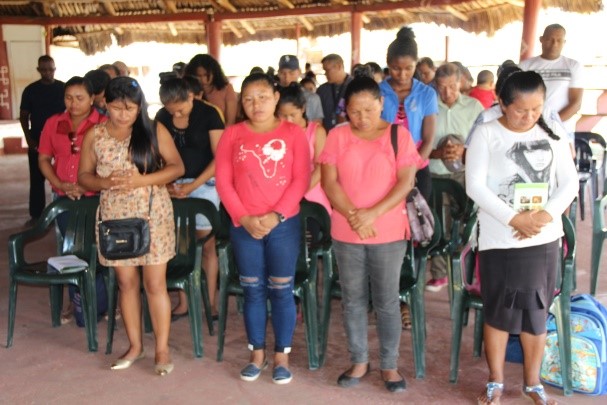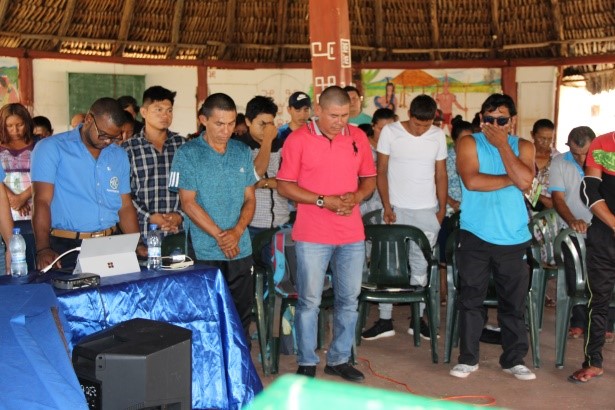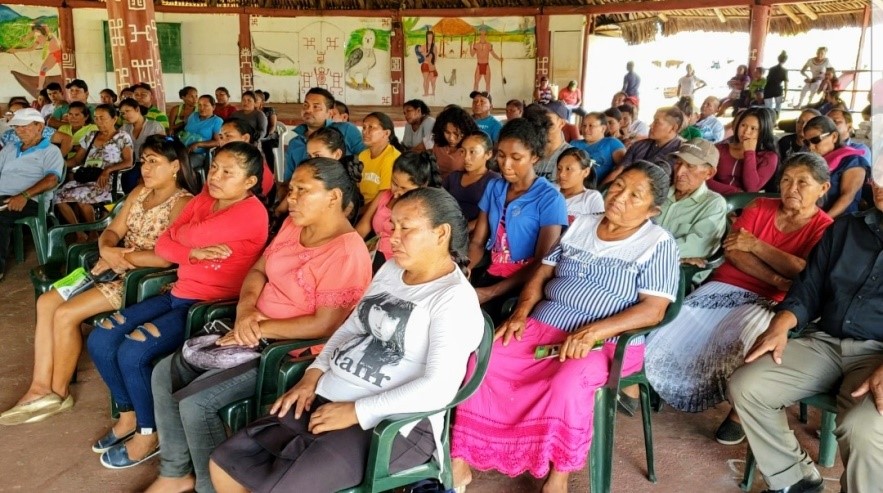Georgetown, July 2019: The Guyana Energy Agency (GEA) recently held a public consultation with stakeholders and residents of the villages of St. Ignatius, Kumu and Quarrie as preparation is advanced for a proposed 1.5 megawatt Kumu Hydropower Project.
With over 140 participants, the consultation which was held in St Ignatius at the ‘Community Benab’ was conducted as part of the process to ensure that both residents and other stakeholders were aware of what the project entails, its benefits to the community and to address any concerns they may have regarding the project. Attendees included representatives from the Regional Democratic Council (RDC), Mayor and Town Council, Rupununi Chambers of Commerce (RCCI), Lethem Power Company (LPC) along with residents of Kumu, St. Ignatius and Quarrie.
Located on the Kumu River of the Co-operative Republic of Guyana, Region 9, the Kumu Hydropower project is a diversion type run-of-the-river plant that is located 15 km southeast of the town of Lethem. The project aims to utilize water from the Kumu River which will facilitate the installation of a 1.5MW plant. It will be connected to the Lethem electrical grid to serve Lethem and nearby villages with electricity.
Regional Vice Chairman Mr. Carl Singh in his remarks highlighted that the RDC is very pleased that the project is moving forward. He further said that “…this consultation is very important as a project of this nature requires all of our input and I would like to thank GEA and the Ministry of Public Infrastructure for including us, the residents, in the process”. Speaking to the project’s alignment with the Green State development Strategy (GSDS), Mr. Singh posited that ”…while the project will allow for a reduction of electricity rate, and that is a very good thing, it also aligns with Guyana’s Green State Development Strategy and the vision for Guyana to become a Green State”. He encouraged those present to view the project as more than just the reduction of electricity cost. Siting global warming and climate change, Mr. Singh said that ‘…the weather pattern was once so reliable that we knew when to plant our cassava and peanuts but because of global warming and climate change we cannot be as certain as we once were. This project will allow us to reduce our carbon emission and allow us to positively impact our environment…the RDC therefore welcomes it and have no objections to the project moving forward”, he concluded.
Town Clerk Ms. Keisha Vincent in her remarks said that “The M&TC of Region 9 welcomes the project and the fact that it will improve our energy sector”. While Toshao of St. Ignatius, Mr. Dinnis Benedict, said that he was “…happy that GEA has included the residents in the process and is facilitating the process of them learning more about the project and is willing to address any questions and concerns they may have”.
Based on questions posed, Hydro Power Support Engineer, Mr. Dolwin Khan, who facilitated the presentation, assured those in attendance that “….the project will be designed to minimize environmental impacts during construction and operation. The Resort at the foot of the hill will not be negatively affected by the hydropower plant”. He further went on to explain that “…the water extracted through the diversion system to operate the hydropower plant will be returned into the river passing through the resort”.
In addressing questions related to possible flooding due to the breaking of the hydro power weir/dam, Mr. Khan affirmed that “this was not a concern given the anticipated design and location of the dam”.
Data gathering, which included location coordinates and flow measurement, for the Kumu Hydro Power Project began in 2013 while a ‘Water Level Logger’ was installed approximately 300 m upstream of the Kumu resort by the GEA with support from the Hydrometeorological Service (Hydromet). This allowed for consistent water level and spot flow measurements were performed throughout the study period.
Mr. Khan explained that “…a significant reduction in the production cost of electricity generated in Lethem is one of the main benefits of the construction of the hydropower station while the need for annual government subventions, which amounts to about 500,000 US Dollars per year, would be eliminated after commissioning”. This he said “…would result in residents benefitting from a decrease in electricity cost…thus the proposed plant would contribute to affordable electricity tariffs”.
Other benefits of the project include:
- To supply electricity from a renewable indigenous energy source to the town of Lethem and its environs (St. Ignatius, Kumu, etc.)
- To promote and increase the use of renewable energy in Guyana
- To support the social and economic development of the town of Lethem and its surrounding communities.
- To reduce the dependence on fossil-based fuels for electricity generation in Lethem
The 1.5 Megawatt Plant will be connected to the Lethem Power Grid, which is operated by the Lethem Power Company Inc. (LPCI) a subsidiary of the state-owned Hinterland Electrification Company Inc. (HECI) that oversees the generation, transmission, distribution and sales of electric energy to customers in the Hinterland region.
In April 1976, Montreal Engineering Company Ltd. (Monenco) conducted a comprehensive study that identified 67 potential sites with over 7,000 Megawatt (MW) of hydropower potential in the country. Guyana, through the GEA, is focused on studying and analyzing the various options for hydropower presented in the study with the ultimate objective of providing a reliable and affordable supply of energy for all within a sustainable framework. It is in this context, the Kumu Hydropower Site located on the Kanuku Mountain range on the Kumu stream was identified for development and is also in keeping with the Green State Development Strategy.
Supervision of the project during the construction phase will be conducted by GEA’s Engineers, along with their counterparts from the HECI and the Lethem Power Company Inc. Additionally, regular updates on the project will be provided to the RDC, Mayor and Councillors of Lethem and the residents in the beneficiary communities.
The project is expected to be funded by the Islamic Development Bank and is expected to become operational by 2025.



